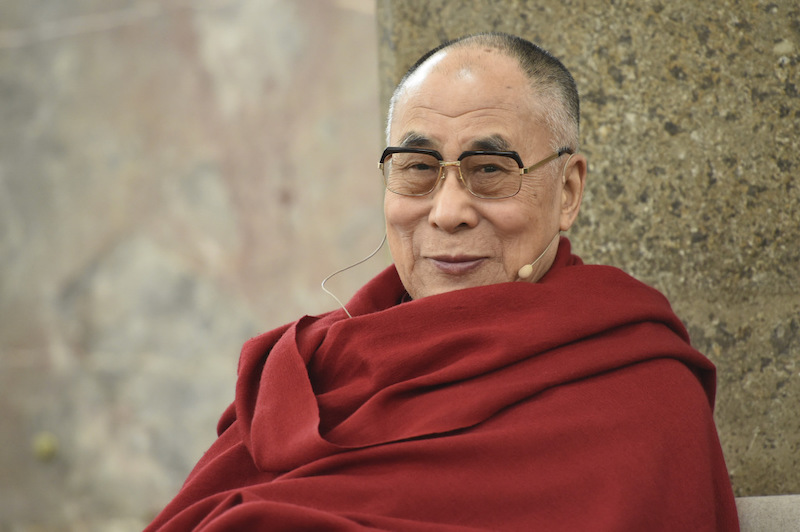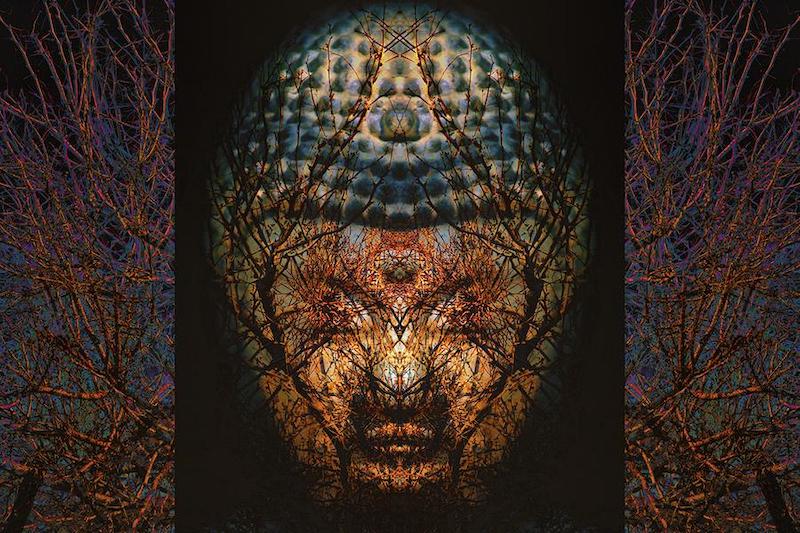James Stanford, “Budding Buddha.” From artfixdaily.com
James Stanford is a longtime Buddhist artist with a distinct aesthetic and inspiration. Last November, he donated his “Budding Buddha” art to the Art for Tibet exhibit and auction at Gallery Eight in New York, which was organized by Students for a Free Tibet.
Can you describe a bit your background in Las Vegas, and how the city’s vintage signage (and general aesthetics) came to have such a strong effect on your artwork?
Everyone has karma. Some people have Tibetan karma; I have Las Vegas karma. I am a native Las Vegan, born and raised in the middle of the Mojave Desert deep in Southwest, United States. As a teenager, I cruised Fremont Street, Glitter Gulch, listening to the Rolling Stones. I was always fascinated by the glow of neon lights.
Las Vegas has always been a matrix for me. It is a great home base. People may have lots of ideas about what Las Vegas is or isn’t. And, they are welcome to believe whatever they want about it. My Las Vegas is like no one else’s. I love my home and my studio and gallery which is a compound with a portion of an ancient Mesquite Bosque. I find Las Vegas to be an excellent place to make artwork, and an incredible place to sell my art. Existing and new collectors are always inspired by the location as it is so unique.
Recent works that draw heavily on Buddhist themes include Lenticular works (2016-2019), and the prismatic Shimmering Zen series (2016-2019). In both projects are themes of light, space, and form. Why do these Buddhist themes resonate with you?
Perhaps the reason for Indra’s Jewels acclaim is that it combines Zen Buddhism with Las Vegas neon signage. Here we find a seeming paradox. Las Vegas is usually portrayed as a realm of samsara (greed and desire). Some claim that Las Vegas is devoid of Nirvana. Part of the message that I hoped to impart is that Las Vegas is as much Nirvana as it is samsara. As an artist, I work with the Buddhist concept of Unity of Polarity. Light and dark, happy, sad, right and wrong, all of these opposites reside on opposing ends of the same pole; I wish to remind everyone that Las Vegas exemplifies the nonduality of nirvana and samsara.
The tension found in displaying supposed opposites on the same picture plane is that these opposites always reside together and form a single unit. It would appear that we cannot know one without experiencing the other. These opposites inform each other. We know each in degrees. It is this understanding that creates an artistic tension in my series “Shimmering Zen.” My use of Las Vegas iconography in the form of a meditative mandala creates a novel view of a complex truth. I believe that great beauty comes alive because of this tension.
Visually, mandalas are symmetrical and contain a mixture of figurative and abstract imagery. At the center of the composition should be a round dot, representing the original creative force, the primordial container of the essence of infinite totality. Mandalas are considered art, and they are also considered to be meditative tools. Those who create them, are trained for many years in both artistic technique and spiritual tradition. Like Hindu and Buddhist mandalas, I intend for my modern mandalas to be appreciated for their beauty as well as for the wisdom they may reveal, which I hope may have the potential to aid viewers in their quest for enlightenment.
I found that there are many ways to teach Buddhism. Since I am a visual artist, I feel the best way for me to impart these truths is through my artwork.
How did you come to be contacted by Students for a Free Tibet? Why did you choose “Budding Buddha” to donate to the auction?
Freeing Tibet from authoritarian oppression is like freeing the human mind from the tyranny of the ego. I chose “Budding Buddha” as it is one of my favorite pieces from my “Buddha Nature” series.

I notice that your Indra’s Jewels series (1998-2015) is stretched over a long period of time. Can you share a bit why, and what inspired you to take on the theme of the Hua-yan/Avatamsaka tradition of Indra’s Net?
Francis H. Cook’s Hua-Yen Buddhism has a beautiful analysis of Indra’s Net. It provides a magnificent metaphor for the Buddhist concept of Interdependence. Since then I have also made a study of Thomas Cleary’s Flower Ornament Scripture: A Translation of the Avatamsaka Sutra, and that led me to Reflecting Mirrors: Perspectives on Huayan Buddhism. Perfect Interpenetration really sums up what I am after in my work. According to this theory, any phenomenon exists only as part of the total nexus of reality, its existence depends on the total network of all other things, which are all equally connected to each other and contained in each other.
Tell me a bit about your Buddhist faith and practice. Does your artistic experience and working life inform at all how you teach Buddhism?
Although I was raised as a Christian, a Baptist, I found that blind faith and a narrow mind was impossible for me to swallow. I found no comfort in the church that I had attended since I was born. I began looking around at other religions and ways of life. After that experience with LSD in 1966 at age 18, I found a glimpse of interdependence and interpenetration. I discovered Zen Buddhism in the same year.
I really got into the habit of making art in order to quiet my mind. I found that if I became involved in drawing, painting, or working on the computer I was entering into a meditative practice. The therapeutic aspect of making art was the first thing that attracted me to the practice of making art. I know many critics would humbug the therapeutic quality of drawing and painting, but for me it was an elixir. The mind calming aspect is more than just feeling good. It is meditation. The mind can chatter away, but eventually shuts up. Time disappears. The self seems to fade away into something greater and more inclusive than our regular discursive thinking. Beyond that, sense of equanimity, there is the joy of creating things that might resonate with others.
Meditation helped deepen my artistic exploration and my Buddhist practice strengthened my resolve to become an accomplished artist. A sense of being a part of everything began to permeate the center of my being. I have practiced meditation for 30 years now.
I have a son who is 41 years old. It was because of him that I sought out a Sangha. The simple message of Zen Master Seung Sahn drew me to the practice of Korean Seon. I wanted to guide my son into a more introspective life, after seeing the fundamentalist gospelizing that was influencing him in his high school. I felt I had to at least expose him to the steadying influence of meditation practice.
I found that there are many ways to teach Buddhism. Since I am a visual artist, I feel the best way for me to impart these truths is through my artwork.
Related blog posts from Buddhistdoor Global
See more

